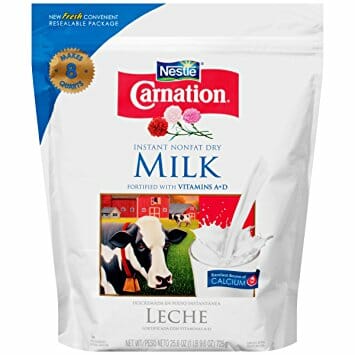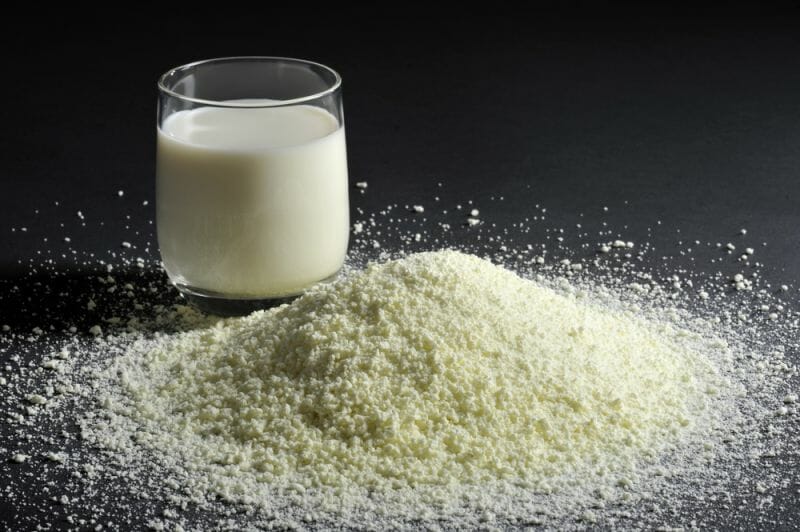Powdered milk, a dairy product made by evaporating milk to a dried form, is a great addition to your pantry.
It is useful as an inexpensive alternative to milk in recipes and is handy to have around when you run out of fresh milk. Powdered milk is also an important item to include in your preparedness stockpile. However, you may be curious how long powdered milk stays fresh.
The answer depends on the type of powdered milk, the container and the storage details.
Some manufacturers suggest using powdered milk within 18 months, but the USDA states that an unopened container of powdered milk can be stored anywhere from two to 10 years after a “best by” date. Some stores market nonfat dry powdered milk labeled with a 25-year shelf life.
What accounts for this wide difference? The type of powdered milk is a big factor. Nonfat powdered milk lasts much longer than powdered whole milk or powdered buttermilk, since milk fat is not stable.
In addition, dried milk lasts longer when it is stored in a container that keeps it protected from moisture and oxygen. For long-term storage, it is best to keep powdered milk unopened in its original container.
Just 30 Grams Of This Superfood Provides More Nutrition Than An Entire Meal!
 An exception to this rule would be if you have purchased powdered milk from a warehouse store like Costco or Sam’s Club in bulk, such as in a 25-pound bag or food grade bucket. These containers are not suitable for long-term storage, so you must repackage the milk. If you have a vacuum sealer, you can repackage the milk in smaller portions in Mylar bags, which you then place into a food-grade bucket.
An exception to this rule would be if you have purchased powdered milk from a warehouse store like Costco or Sam’s Club in bulk, such as in a 25-pound bag or food grade bucket. These containers are not suitable for long-term storage, so you must repackage the milk. If you have a vacuum sealer, you can repackage the milk in smaller portions in Mylar bags, which you then place into a food-grade bucket.
If you do not have a vacuum sealer, you can use one-gallon zippered freezer bags along with oxygen absorbers.
Powdered milk lasts longer when it is stored away from light in a dark cupboard or in an opaque can or Mylar bag. Temperature also factors greatly into successful long-term storage of powdered milk.
A study by Utah State University found that storage at 50 degrees Fahrenheit preserves the milk’s flavor the best. By contrast, study samples stored at 90 degrees Fahrenheit lost their flavor after only six months and were unusable after two years. Stored at 70 degrees Fahrenheit, dried milk tasted bad after four years.
The study also determined that the vitamin content of powdered milk declines slowly over time. Other nutrients such as protein, carbohydrates and minerals, however, remain unchanged for years.
Freezing powdered milk is a good option for long-term storage. Seal the package well – vacuum sealing is best — to prevent freezer burn, and then you can keep the milk frozen indefinitely.
Label any container with the date you have opened it, and use its contents within three months. Once you reconstitute nonfat dry milk, place it in the refrigerator and plan to use it all within five days.
How can you tell if powdered milk is not fresh? Telltale signs are a yellow discoloration and a bad odor. Both indicate that moisture has entered the package, and there is a chance mold and/or bacteria are present in these circumstances. When in doubt, it is best to discard the milk.
Do you store powdered milk? What advice would you add? Share your tips in the section below:
For more information, here are a few resources:
https://extension.usu.edu/foodstorage/htm/dried-milk
https://digitalcommons.usu.edu/cgi/viewcontent.cgi?article=1611&context=extension_histall
 Off The Grid News Better Ideas For Off The Grid Living
Off The Grid News Better Ideas For Off The Grid Living




